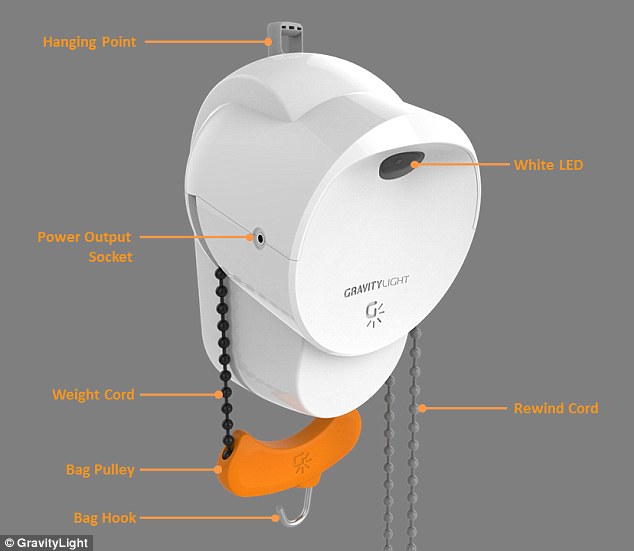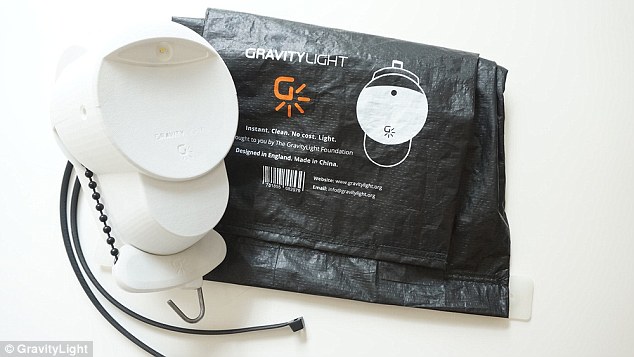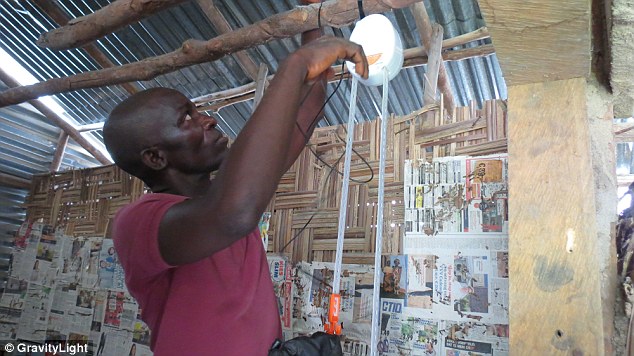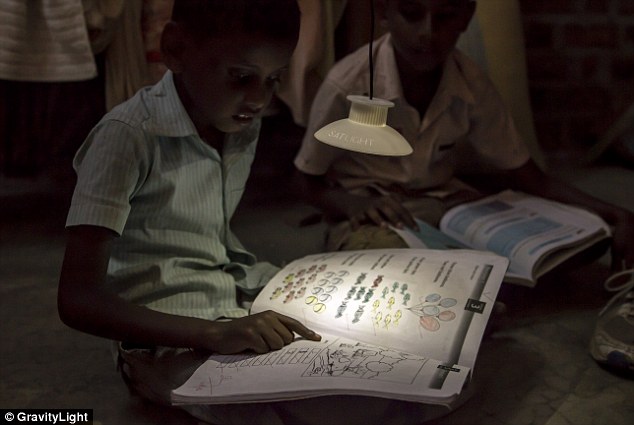Friday, 26/12/2025 | 08:43 GMT+7
The GravityLight is aimed at helping the 1.3 billion people who live without electricity in areas of the world too remote or poor to have a reliable grid.
It works using a pulley system where a weight can be fixed at one end and as it drops the force drives a generator through a series of low torque gears.
The generator produces just under a tenth of a watt which powers an LED light on the unit itself and two smaller satellite lights that can be hung over a desk or bed.
The device means families can replace their dangerous kerosene lamps that are common in many parts of the world to light activities after dark.
The device is installed to the ceiling of a room and a bag filled with around 26ft (12kg) of rocks or sand is attached to a cord that runs through the unit.
A beaded cord running through the unit allows the weight to be lifted into the air and it then falls slowly to the ground.
A system of gears and a generator inside the device convert the kinetic energy released by the bag as it falls under the influence of gravity into electricity.
Once the bag reaches the ground it can be raised back up to the ceiling to produce more power.
The energy produced can be used to power the light and other devices attached to a DC power outlet.
The generator produces just under a tenth of a watt which powers and provides between 20 to 30 minutes of light if installed at a height of over 6ft (1.8 metres).
Jim Reeves and Martin Riddiford, who are based in London, invented the device.
They point out that unlike devices that rely upon solar energy to provide power to remote communities, gravity does not disappear at night.
Mr Reeves said: 'One in five people don't have access to electricity.
'For families living on just a few dollars a day, kerosene lamps can consume up to 30% of their income creating an ongoing poverty trap.
'With GravityLight, all you need is a weight.'
The team have already tested their prototype GravityLight in 1,300 homes in 27 different countries.
They have now launched a campaign on Indiegogo to help raise funds to produce a second generation of light that is easier to raise the weight and lasts for longer.
They are also working with a factory in Kenya to begin producing the lights. It costs £45 ($70) to buy a new GravityLight with two SatLights.
According to Mr Riddiford: 'GravityLight is a low cost, safe and reliable alternative to the kerosene lamp.
'It costs nothing to run, doesn't need batteries and pays for itself within weeks of switching from kerosene.'






Mai Linh








 Webinar 2: “Financial Support for Energy Efficiency Enterprises – Opportunities and Challenges”
Webinar 2: “Financial Support for Energy Efficiency Enterprises – Opportunities and Challenges”
 Vietnamese enterprises achieve green growth and cut costs through energy efficiency
Vietnamese enterprises achieve green growth and cut costs through energy efficiency
 Capacity Building for Program Implementing Entity
Capacity Building for Program Implementing Entity
 Enhance Energy Efficiency Knowledge for Managers of Cement Industrial Enterprises
Enhance Energy Efficiency Knowledge for Managers of Cement Industrial Enterprises
 Capacity building for participating financial institutions of the VSUEE Project
Capacity building for participating financial institutions of the VSUEE Project
 Capacity building for participating financial institutions in Ho Chi Minh City
Capacity building for participating financial institutions in Ho Chi Minh City
 Strengthening capacity for energy management officers of local government agencies
Strengthening capacity for energy management officers of local government agencies